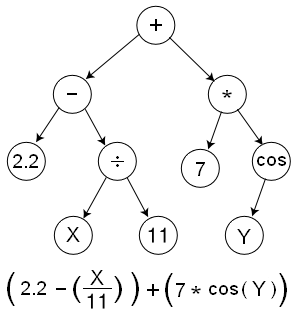Genetic programming
Genetic programming (GP) is a type of evolutionary algorithm and machine learning technique that automatically creates computer programs to solve problems. It is inspired by the process of natural selection and genetic evolution in biology.
Overview[edit | edit source]
Genetic programming is a domain-independent method that evolves programs to perform specific tasks. It starts with a population of random programs and evolves them over generations. The evolution process involves selection, crossover (recombination), mutation, and reproduction.
History[edit | edit source]
The concept of genetic programming was first introduced by John Koza in the early 1990s. Koza demonstrated that GP could solve a wide range of problems, including symbolic regression, classification, and control problems.
Process[edit | edit source]
The genetic programming process typically involves the following steps:
1. **Initialization**: Generate an initial population of random programs. 2. **Selection**: Evaluate the fitness of each program and select the best-performing programs. 3. **Crossover**: Combine parts of two or more selected programs to create new programs. 4. **Mutation**: Randomly alter parts of a program to introduce variability. 5. **Reproduction**: Copy the best programs to the next generation. 6. **Termination**: Repeat the process until a stopping criterion is met, such as a maximum number of generations or a satisfactory fitness level.
Applications[edit | edit source]
Genetic programming has been applied to various fields, including:
Advantages and Disadvantages[edit | edit source]
Advantages[edit | edit source]
- Can automatically discover solutions without human intervention.
- Capable of solving complex, non-linear problems.
- Flexible and can be applied to various domains.
Disadvantages[edit | edit source]
- Computationally expensive and time-consuming.
- Solutions may be difficult to interpret.
- Requires careful tuning of parameters.
Related Techniques[edit | edit source]
Genetic programming is part of a broader family of evolutionary algorithms, which also includes:
See Also[edit | edit source]
- Artificial intelligence
- Machine learning
- Evolutionary computation
- Natural selection
- Genetic algorithm
References[edit | edit source]
External Links[edit | edit source]
Lua error in package.lua at line 80: module 'strict' not found.
Search WikiMD
Ad.Tired of being Overweight? Try W8MD's physician weight loss program.
Semaglutide (Ozempic / Wegovy and Tirzepatide (Mounjaro / Zepbound) available.
Advertise on WikiMD
|
WikiMD's Wellness Encyclopedia |
| Let Food Be Thy Medicine Medicine Thy Food - Hippocrates |
Translate this page: - East Asian
中文,
日本,
한국어,
South Asian
हिन्दी,
தமிழ்,
తెలుగు,
Urdu,
ಕನ್ನಡ,
Southeast Asian
Indonesian,
Vietnamese,
Thai,
မြန်မာဘာသာ,
বাংলা
European
español,
Deutsch,
français,
Greek,
português do Brasil,
polski,
română,
русский,
Nederlands,
norsk,
svenska,
suomi,
Italian
Middle Eastern & African
عربى,
Turkish,
Persian,
Hebrew,
Afrikaans,
isiZulu,
Kiswahili,
Other
Bulgarian,
Hungarian,
Czech,
Swedish,
മലയാളം,
मराठी,
ਪੰਜਾਬੀ,
ગુજરાતી,
Portuguese,
Ukrainian
Medical Disclaimer: WikiMD is not a substitute for professional medical advice. The information on WikiMD is provided as an information resource only, may be incorrect, outdated or misleading, and is not to be used or relied on for any diagnostic or treatment purposes. Please consult your health care provider before making any healthcare decisions or for guidance about a specific medical condition. WikiMD expressly disclaims responsibility, and shall have no liability, for any damages, loss, injury, or liability whatsoever suffered as a result of your reliance on the information contained in this site. By visiting this site you agree to the foregoing terms and conditions, which may from time to time be changed or supplemented by WikiMD. If you do not agree to the foregoing terms and conditions, you should not enter or use this site. See full disclaimer.
Credits:Most images are courtesy of Wikimedia commons, and templates, categories Wikipedia, licensed under CC BY SA or similar.
Contributors: Prab R. Tumpati, MD



